The Surrender of the U190
1
The German submarine U-190, a Type IXC/40 was commissioned on September 24, 1942 in Bremen, not far from Hamburg, the home of it's last German Captain, Hans Edwin Reith and many of it's crew. Out of her six operational patrols she sunk two allied vessels, the 7,015 ton cargo ship Empire Lakeland on March 8, 1943 and the Bangor Class Minesweeper HMCS Esquimalt on April 16, 1945. The U-190 continued to patrol the Newfoundland coastline until the war's end. On May 11, 1945, the U190 surfaced and her crew began dumping what appeared to be secret materials, torpedoes and ammunition overboard. Her Black Flag flying, she surrendered to the RCN on May 12, 1945, about 500 miles(850 fms) east of Cape Race. The submarine was escorted to Bay Bulls, then on to St. John's and eventually to Halifax where it was commissioned into the Canadian Navy. Reith spent two years as a POW, one year in Canada and one year in Germany under the direction of the British.
2
German Submarine U-190
May 1945
Bay Bulls, Newfoundland
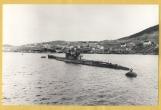 Credits:
Credits:
Maritime Command Museum
Crow's Nest, U-190 Photo Album
3
Photograph of the Black Surrender Flag from the German Submarine U-190
May 1945
St. John's, Newfoundland, Canada
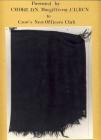 Credits:
Credits:
Crow's Nest, U-190 Photo Album
4
Oberleutnant Hans Edwin Reith, captain of the German Submarine U-190
May 1945
St. John's Harbour, Newfoundland
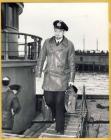 Credits:
Credits:
Maritime Command Museum
Crow's Nest, U-190 Photo Album
5
German Submarine U-190 Captain's Cabin
May 1945
St. John's Harbour, Newfoundland
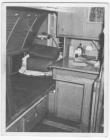 Credits:
Credits:
James Hawke Collection
2007-2008 Album, Crow's Nest
6
U-190's Captain Trying to Block View from Canadian Sailor's Camera
May 1945
St. John's Harbour, Newfoundland
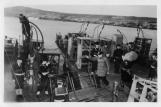 Credits:
Credits:
James Hawke Collection
2007-2008 Album, Crow's Nest
7
Werner Hirschmann, Chief Engineer and Crew Members of the German Submarine U-190
St. John's Harbour, Newfoundland
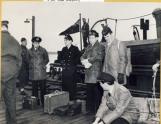 Credits:
Credits:
Maritime Command Museum
Crow's Nest, U-190 Photo Album
8
The U-190 had a name. It was Stern Von Rio (Star of Rio), represented by the star painted on the coning tower. Some say this name came from the boat's inaugural trip which was supposedly to Rio but others recall it simply as the name to a popular song in Germany at the time. Hirschmann the U-190's chief engineer, says it was only a compass rose.
9
Canadian and German crewmembers on the German Submarine U-190
May 1945
St. John's Harbour, Newfoundland
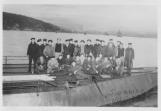 Credits:
Credits:
James Hawke Collection
2007-2008 Album, Crow's Nest
10
Capture of the German Submarine U-190
May 1945
St. John's Harbour, Newfoundland
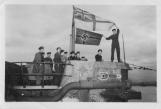 Credits:
Credits:
James Hawke Collection
2007-2008 Album, Crow's Nest
11
German Submarine U-190 Officers Surrendering
May 1945
St. John's Harbour, Newfoundland
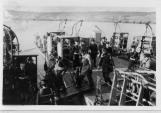 Credits:
Credits:
James Hawke Collection
2007-2008 Album, Crow's Nest
12
German Crew from the Submarine U-190
May 1945
St. John's Harbour, Newfoundland
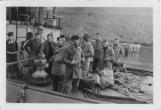 Credits:
Credits:
James Hawke Collection
2007-2008 Album, Crow's Nest
13
There is no doubt that no single fighting service on either side suffered such high losses in men and equipment than the U-boats. About 70 percent of Germany's 980 subs were lost. Only 6000 of the 38,000 officers and men who fought in them, survived the war.
14
German Submarine U-190, under escort, entering St. John's Harbour
St. John's Harbour, Newfoundland
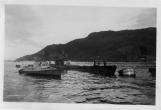 Credits:
Credits:
James Hawke Collection
2007-2008 Album, Crow's Nest
15
German Submarine U-190, tied up at Naval Dockyard
1945
St. John's Harbour, Newfoundland
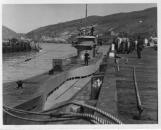 Credits:
Credits:
James Hawke Collection
2007-2008 Album, Crow's Nest
16
As a prize of war, The Royal Canadian Navy used the U-190 as a familiarization and training submarine. During "Operation Scuttled" in 1947, the U-190 was sent to the bottom outside Halifax Harbour, close to where she sunk her last victim, HMCS Esquimalt.
17
After Torpedo Room
1945
St. John's, Newfoundland, Canada
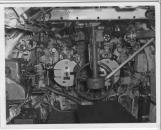 Credits:
Credits:
James Hawke Collection
2007-2008 Album, Crow's Nest
18
German Submarine U-190 Gun
1945
St. John's, Newfoundland, Canada
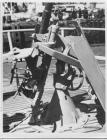 Credits:
Credits:
James Hawke Collection
2007-2008 Album, Crow's Nest
19
Set of Guns on the German Submarine U-190
1945
St. John's Harbour, Newfoundland
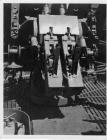 Credits:
Credits:
James Hawke Collection
2007-2008 Album, Crow's Nest
20
German Submarine U-190's Periscope Deck Mounts
1945
St. John's Harbour, Newfoundland
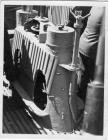 Credits:
Credits:
James Hawke Collection
2007-2008 Album, Crow's Nest
21
German Submarine U-190 Central Electrical Panel
1945
St. John's Harbour, Newfoundland
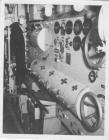 Credits:
Credits:
James Hawke Collection
2007-2008 Album, Crow's Nest
22
Part of the Central Room on the German Submarine U-190
1945
St. John's Harbour, Newfoundland
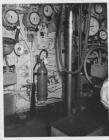 Credits:
Credits:
James Hawke Collection
2007-2008 Album, Crow's Nest
23
The periscope from the U-190 stands secure in the Crow's Nest's top floor and now peers out over Water Street. During the war it was used to search for potential victims.
24
The Periscope off the German Submarine U-190, Now in the Crow's Nest
2007
St. John's, Newfoundland, Canada

25
U-190 Periscope Protruding Through the Roof of the Crow's Nest
2007
St. John's, Newfoundland, Canada

|


 Credits:
Credits: Credits:
Credits:
















